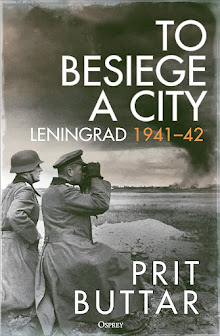The Battle of Anzio started with an amphibious attack (Operation Shingle) on 22 Jan 1944. A lack of aggressive spirit on the part of the attacking force and a highly energised reaction from the German commander, Field Marshall Albert Kesselring, meant that despite initial Allied success the bridgehead was penned in by eight German divisions within a matter of days. Winston Churchill famously remarked that I had hoped to that we were hurling a wildcat onto the shore, but all we got was a stranded whale. The American commander, Major General John P Lucas, was relieved of his command a few weeks later having, in the meantime, overseen the successful rebuttal of a major counter attack by the German 14th Army.
 |
| The Town Beach at Anzio |
The initial assault on Anzio town was spearheaded by the U.S. Rangers and the U.S. 504th & 509th infantry battalions. The photo above shows the town beach as it is now. The harbour is just beyond the promontory. In contemporary photographs one can see the massive tank landing ships discharging vehicles onto the beach and helpfully there is a superb model of one of these craft in the Anzio Landings Museum. The U.S. 3rd Division landed to the east of nearby Nettuno, which like Anzio, was captured on the first day. The British 1st Division and 3rd Brigade along with a Canadian regiment landed to the north of Anzio and were equally successful as far as the initial disembarkation was concerned.
On this road-trip our battlefield walking group was concerned with the 56th (London) Division who reached the Anzio Bridgehead on 18 February 1944, disembarking in the main harbour. They'd set out from Bagnoli, Naples three days earlier. Our visit to this busy commercial harbour was an interesting one - including a rather bizarre barter transaction where the purchase of five pairs of socks gave us a prime parking spot next to the fish market!
On this road-trip our battlefield walking group was concerned with the 56th (London) Division who reached the Anzio Bridgehead on 18 February 1944, disembarking in the main harbour. They'd set out from Bagnoli, Naples three days earlier. Our visit to this busy commercial harbour was an interesting one - including a rather bizarre barter transaction where the purchase of five pairs of socks gave us a prime parking spot next to the fish market!
 |
| Bagnoli Harbour, Naples |
On our way up to Anzio (by road) we sought out some of the areas where the 56th Division fought before they were pulled back to Pozzuoli near Naples to prepare for the Anzio 'show'. During the autumn and winter of 1943/44 the 56th Division fought its way through Maddaloni, Caserta and Capua before crossing the River Volturno.
The last major action that the 56th Division were involved with during this stage of the campaign was the opposed crossing of the River Garigliano at the extreme western end of the German Gustav Line.
 |
| Crossing the River Garigliano |
 |
| Site of Military Medal Action |
Upon reaching Anzio we sought out a site that had been featured in the always excellent After the Battle magazine. This was the last pillbox of the Anzio-Nettuno seafront defences which was converted into an artwork by the sculptor Amerigo Tot in April 1976. The ATB team caught a team of construction workers beginning to make the modifications and the ATB cover photo is reproduced below along with two of our party in a much later shot. The 'artwork' is now in a very sorry state.
 |
| Anzio - Then & Now 1944 & 2019 |
The flyover at Campo Di Carne is a major feature of the battlefield and the fighting in this area was intense during the German counter attack 16-20 February, 1944 and afterwards as the Allied troops sought to take the town of Aprilia (known to the troops on the ground as 'The Factory').
 |
| The Flyover - Feb 1944 |
 |
| The Flyover - May 2019 |
As we were investigating the environs we came across a road sign pointing the way to The British 'Waters Memorial'. Intrigued we set off to find it - with some difficulty it must be said. I'm glad we took the trouble because, being a fan of Pink Floyd, I was astonished to find that one of the groups' founders, Roger Waters, had taken the trouble to locate where his father was killed in action on 18 February, 1944 and had erected a poignant little memorial and a really useful information board.
 |
| 2nd Lt Eric Waters & Family |
 |
| Memorial to Lt Eric Fletcher Waters - Aprilia, Italy |
The 56th Division was withdrawn from the Anzio Bridgehead and returned to Egypt on 28 March 1944 where they were refitted - returning to Italy in July 1944 in time to offer a royal salute to King George VI at a victory parade on the 30th of that month.




















